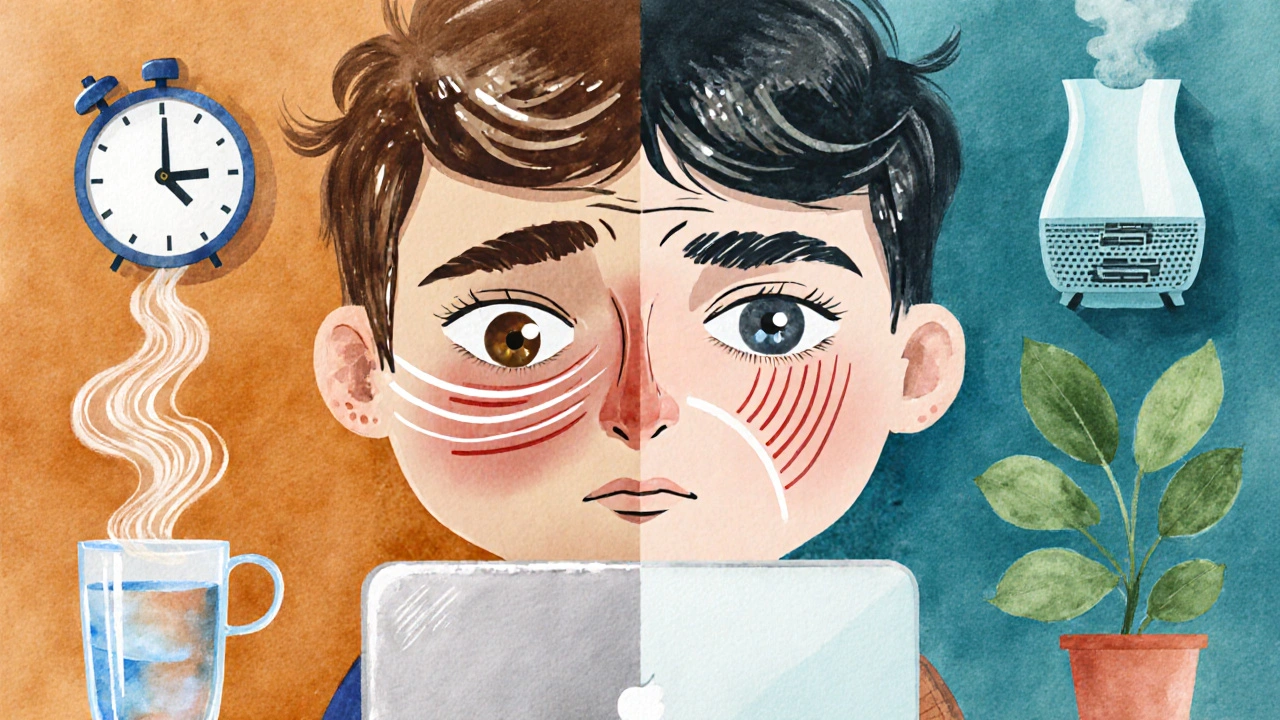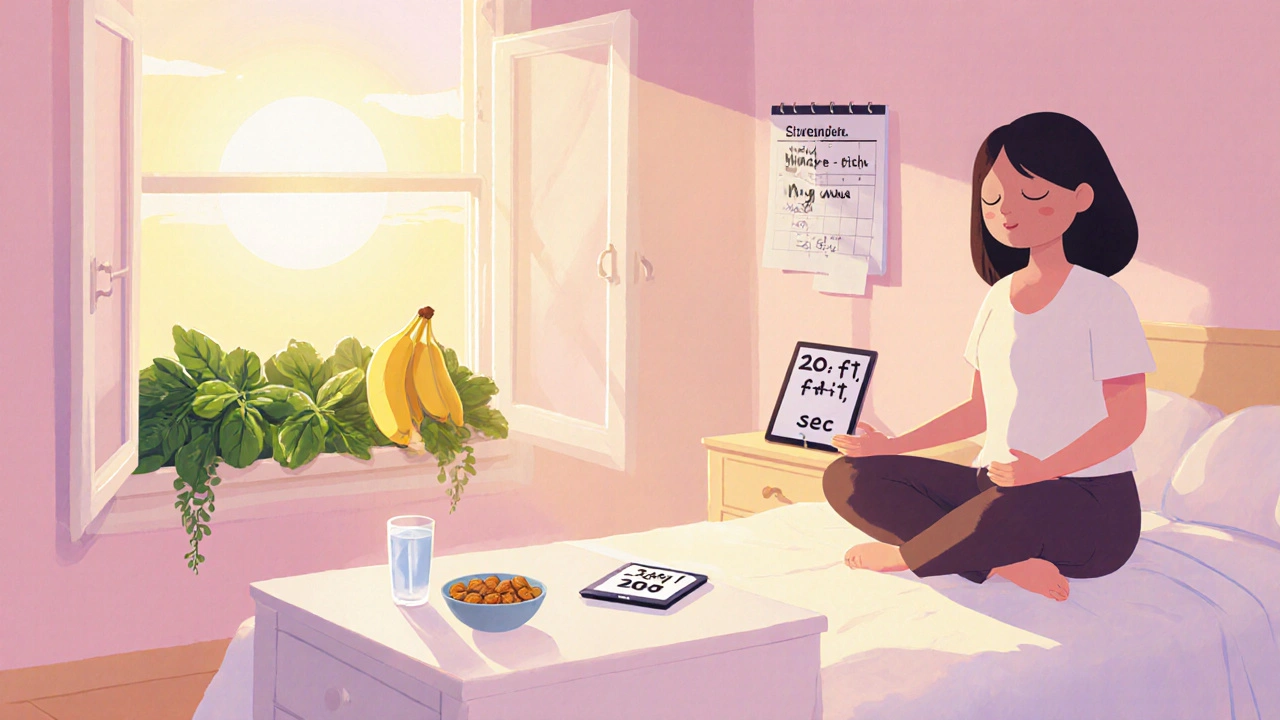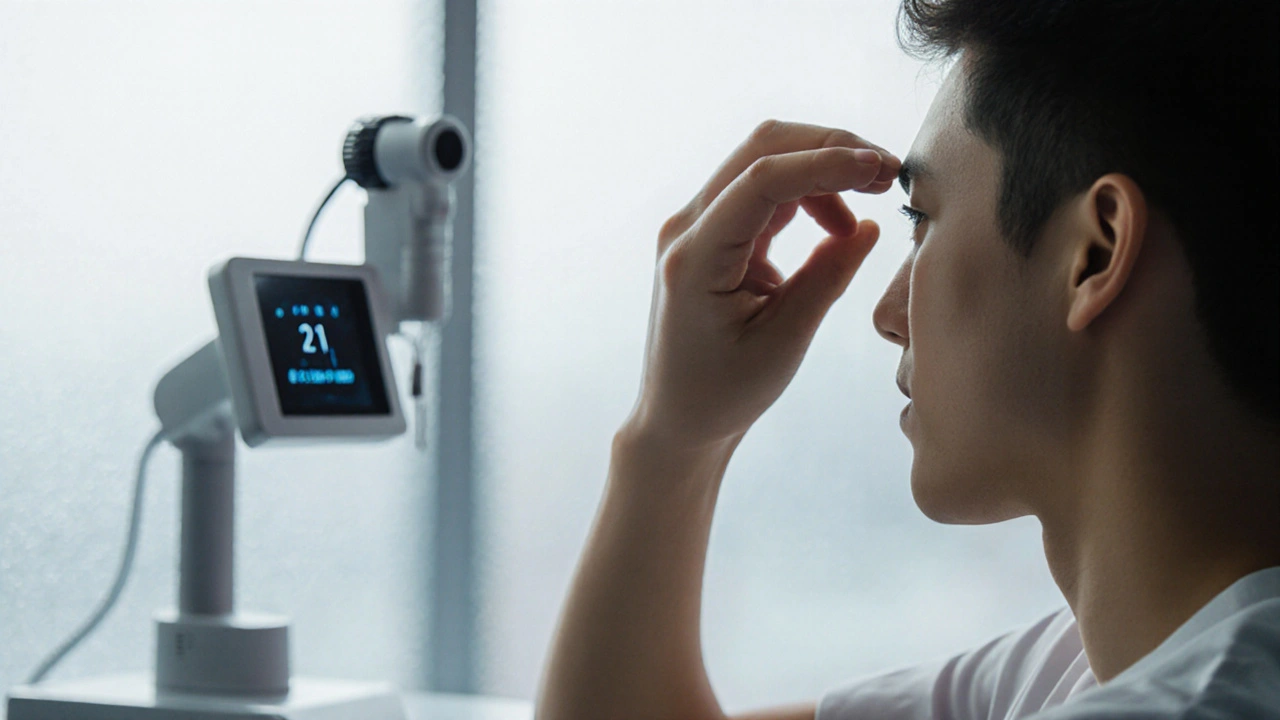Eye Pressure & Twitch Calculator
Assess Your Eye Health Risk
Enter your lifestyle factors to see potential impact on eye pressure and twitching frequency
Your Eye Pressure Estimate
Normal range: 10-21 mm Hg
Note: This is an estimate based on lifestyle factors only
Eye Twitch Frequency Estimate
Frequency:
Personalized Recommendations
Ever caught yourself rubbing a fluttering eyelid while a routine eye check shows higher than normal numbers? You’re not alone. Many people wonder if a spike in high eye pressure could be behind that annoying eye twitch. The short answer is: they can share triggers, but one doesn’t directly cause the other. This article untangles the facts, explains the biology, and gives you clear steps to keep both your eyes and nerves happy.
Key Takeaways
- Ocular hypertension (high eye pressure) and eye twitching are separate conditions with overlapping lifestyle triggers.
- Stress, caffeine, dehydration, and lack of sleep can aggravate both.
- Persistent high eye pressure raises glaucoma risk; constant twitching may indicate nerve irritation or vitamin deficiency.
- Simple habits-regular breaks from screens, balanced hydration, and stress management-help reduce both symptoms.
- Seek an eye‑care professional if pressure stays above 21mmHg or twitches last longer than a week.
What Is High Eye Pressure?
Ocular hypertension is a condition where the fluid pressure inside the eye, known as intraocular pressure (IOP), is higher than the normal range (typically above 21mmHg) without any detectable damage to the optic nerve. The fluid, called aqueous humor, constantly circulates to nourish the eye and then drains through a tiny meshwork called the trabecular meshwork. When drainage slows down, pressure builds up.
Unlike glaucoma, ocular hypertension doesn’t yet show vision loss, but it’s a major risk factor. If left unchecked, the pressure can push on the optic nerve the bundle of retinal ganglion cell axons that transmits visual information to the brain, eventually causing irreversible damage.
What Causes Eye Twitching?
Eye twitching (or myokymia) is a brief, involuntary contraction of the orbicularis oculi muscle around the eyelid. Most twitches are harmless and resolve within minutes, but they can become frequent when certain triggers pile up.
Common culprits include:
- Physical fatigue or prolonged screen time.
- Dry eyes from low humidity or contact lenses.
- Excessive caffeine or alcohol.
- Stress and anxiety.
- Electrolyte imbalances, especially low magnesium or potassium.

Shared Triggers: Where the Two Overlap
While high eye pressure and eye twitching arise from different physiological pathways, they often coexist because they respond to the same lifestyle factors.
Stress the body’s hormonal response to mental or physical pressure, releasing cortisol and adrenaline can cause pupil dilation, temporarily raising IOP, and also tighten facial muscles, sparking twitches.
Caffeine a stimulant that blocks adenosine receptors, raising heart rate and stimulating the nervous system is known to increase IOP modestly and heighten muscle excitability, making eyelid spasms more likely.
Dehydration a state where the body lacks sufficient water to maintain normal cellular function reduces aqueous humor turnover, potentially nudging pressure upward, while also altering electrolyte balance, a trigger for myokymia.
Insufficient sleep magnifies both issues by reducing the eye’s ability to clear metabolic waste during the nightly glymphatic flush and by increasing sympathetic nervous activity.
How High Intraocular Pressure Might Influence Twitching
There’s no direct cause‑and‑effect link, but a few plausible mechanisms exist:
- Mechanical irritation: Elevated IOP can press on the scleral wall, subtly shifting the eyelid’s attachment points and sensitizing the orbicularis muscle.
- Vascular changes: Higher pressure may compromise microcirculation around the extraocular muscles, leading to brief ischemic spikes that trigger spasms.
- Neurological stress: The eye’s afferent pathways share connections with facial nuclei; chronic pressure can increase neural firing rates, indirectly priming twitch‑prone circuits.
These theories are supported by small clinical observations where patients with uncontrolled ocular hypertension reported more frequent eyelid twitches than those with stable pressures.
When to Seek Professional Help
Not all twitches warrant a doctor, but certain red flags signal a deeper issue.
- If your glaucoma a group of eye diseases characterized by optic nerve damage often associated with high intraocular pressure risk factors (family history, African or Asian ancestry) are present, schedule an eye exam even if you feel fine.
- Persistent IOP readings above 21mmHg on at least two separate visits require treatment-eye drops, laser therapy, or lifestyle adjustments.
- Eye twitching that lasts more than a week, spreads to other facial muscles, or is accompanied by vision changes (blurriness, halos) should be evaluated for neurological or ocular surface disorders.

Prevention and Lifestyle Tips
Below are evidence‑backed habits that simultaneously lower eye pressure and calm eyelid muscles.
- Hydrate wisely: Aim for about 2L of water daily; add a pinch of sea salt or an electrolyte drink if you sweat heavily.
- Limit caffeine to 200mg per day: Roughly one 12‑oz coffee. Swap the second cup for herbal tea.
- Take screen breaks: Follow the 20‑20‑20 rule-every 20 minutes, look at something 20feet away for 20 seconds.
- Manage stress: Short mindfulness sessions, breathing exercises, or a quick walk can drop cortisol levels and reduce both IOP spikes and muscle tension.
- Prioritize sleep: 7‑9hours of quality rest supports the eye’s waste‑clearance system and keeps the nervous system balanced.
- Watch your diet: Foods rich in magnesium (leafy greens, nuts) and potassium (bananas, sweet potatoes) help keep electrolytes steady.
- Regular eye checks: An annual dilated exam catches ocular hypertension early, allowing timely intervention before glaucoma develops.
Quick Checklist
- Drink 8 glasses of water a day.
- Keep caffeine ≤200mg.
- Use the 20‑20‑20 screen rule.
- Practice 5‑minute stress‑relief breathing.
- Sleep 7-9hours nightly.
- Eat magnesium‑rich foods 3 times/week.
- Schedule an eye exam if you’re over 40 or have a family history of glaucoma.
Comparison of Common Triggers
| Trigger | Effect on IOP | Effect on Eyelid Muscles |
|---|---|---|
| Caffeine | ~1-2mmHg rise (temporary) | Increased neuromuscular excitability → more twitches |
| Stress | Elevates cortisol → modest IOP increase | Triggers facial muscle tension |
| Dehydration | Reduced aqueous outflow → possible pressure build‑up | Electrolyte shift → muscle spasms |
| Sleep deprivation | Impaired glymphatic clearance → pressure fluctuations | Fatigued muscles fire erratically |
| Medications (e.g., steroids) | Can raise IOP significantly | Rarely cause twitching directly |
Frequently Asked Questions
Can eye twitching be a sign of glaucoma?
Usually not. Glaucoma primarily affects the optic nerve and vision field. A twitch is more often linked to muscle fatigue, stress, or electrolyte issues. However, if you have risk factors for glaucoma, get your pressure checked regularly.
Does drinking more water lower eye pressure?
Adequate hydration supports normal aqueous humor turnover, which can help keep intraocular pressure in a healthy range. It’s not a cure, but it’s a useful supportive habit.
How long should an eye twitch last before I’m worried?
Most twitches resolve within a few minutes to a couple of days. If it persists for more than a week, spreads to other facial muscles, or is paired with vision changes, see a doctor.
Are there eye‑drop medications that lower pressure without causing twitching?
Common pressure‑lowering drops (e.g., prostaglandin analogs, beta‑blockers) don’t typically affect eyelid muscles. Side effects usually involve mild redness or a change in eyelash growth, not twitching.
Can lifestyle changes replace medical treatment for high eye pressure?
Lifestyle tweaks (hydration, caffeine moderation, stress control) can help stabilize pressure, but they don’t replace prescription therapy when IOP is consistently high. Always follow your eye‑care professional’s guidance.
By understanding the shared triggers and taking a few practical steps, you can keep both your intraocular pressure and eyelid muscles in check. Remember: occasional twitches are normal, but sustained high pressure is a warning sign that deserves professional attention.


Comments (15)
I've been digging through the research on ocular hypertension, and it's fascinating how lifestyle factors keep popping up. Even a slight dip in hydration can nudge teh intra‑ocular pressure upward, which many people overlook. So, while the calculator is a neat tool, remember it's just a rough guide, not a medical diagnosis. Stay curious and keep tracking your habits!
Sure, because the government’s secret eye‑pressure agenda is totally real.
When it comes to eye health, the interplay between intra‑ocular pressure and neuromuscular excitability is more nuanced than a simple cause‑and‑effect diagram might suggest.
First, the eye’s aqueous humor dynamics are regulated by a delicate balance of production and outflow, and any disruption can shift pressures by a few millimetres of mercury.
Second, the orbicularis oculi muscle that governs eyelid movement responds to systemic neurotransmitter levels, especially those influenced by caffeine and stress.
Third, both systems share common upstream triggers such as elevated cortisol, which can constrict blood vessels and subtly alter ocular perfusion.
Fourth, dehydration reduces plasma volume, which may decrease the rate at which aqueous humor is cleared, potentially nudging pressure upward.
Fifth, sleep deprivation impairs the glymphatic clearance pathways that clear metabolic waste from the retina overnight, thereby affecting pressure regulation.
Sixth, genetic predisposition to ocular hypertension can amplify the impact of these lifestyle factors, making some people more sensitive to caffeine spikes.
Seventh, the nervous system’s sympathetic branch becomes overactive under chronic stress, leading to a cascade of hormonal changes that influence both eye pressure and muscle twitch propensity.
Eighth, electrolyte imbalances, particularly low magnesium, can increase neuromuscular excitability, making twitches more frequent even when pressure remains within normal limits.
Ninth, the literature does contain small cohort studies that observed a higher prevalence of eyelid myokymia among patients with uncontrolled intra‑ocular pressure, though causality has not been definitively proven.
Tenth, because the eye is a closed compartment, even modest pressure variations can be sensed by mechanoreceptors that feed back to the facial nucleus, potentially priming twitch circuits.
Eleventh, lifestyle interventions such as reducing caffeine intake to under 200 mg per day, staying well‑hydrated, and ensuring 7‑9 hours of sleep have been shown to modestly lower both IOP and twitch frequency in prospective trials.
Twelfth, these interventions are low‑risk and accessible, making them a practical first line before pharmacologic therapy is considered for ocular hypertension.
Thirteenth, however, if intra‑ocular pressure consistently exceeds 21 mmHg on multiple readings, an ophthalmologist may prescribe prostaglandin analogues or beta‑blocker drops, which do not typically affect eyelid muscles.
Fourteenth, patients should also be screened for vitamin deficiencies, especially B‑complex and magnesium, as these can contribute to neuromuscular irritability.
Finally, the key takeaway is to view eye pressure and twitching as parallel signals from a shared lifestyle environment rather than a direct domino effect, and to act on the modifiable factors wherever possible.
Interesting overview, but you’re ignoring the fact that most people just need to cut the coffee and stop staring at screens all day. Also, a quick eye exam can catch issues long before they become serious, so don’t procrastinate.
It’s disheartening how often we romanticize “busy lives” while silently encouraging habits that sabotage our eyesight. Prioritizing a few extra minutes of sleep isn’t just a personal choice; it’s a public health responsibility. We owe it to ourselves and future generations to model healthier screen habits.
Sleep, like a nightly tide, clears the mental clutter that clouds both vision and thought. When we honor that rhythm, we’re not just protecting the eyes but also nurturing the mind’s quiet spaces.
Great points keep it simple stay hydrated and limit coffee you’ll see the difference
Honestly, the article reads like a recycled wellness brochure penned by someone who’s never actually measured their own intra‑ocular pressure. The so‑called “evidence‑backed habits” are a hodgepodge of buzzwords thrown together with zero nuance, and the tone borders on condescending, as if we’re all clueless toddlers. While the calculator might look slick, it oversimplifies a complex physiological process into a few sliders, which is frankly insulting to anyone who’s studied ophthalmology. Moreover, the recommendation to “drink more water” is a lazy platitude that ignores the role of electrolyte balance and systemic vascular health. If you want actionable advice, start with a proper dilated exam rather than relying on a gimmicky web widget. In short, skip the fluff and consult a qualified eye‑care professional.
By the way, I’ve been meaning to ask-do you ever notice how your own eye‑twitch patterns change after a night out? It’s something I track obsessively and could share some data.
Tracking personal patterns can indeed reveal correlations that are otherwise invisible, especially when paired with objective measurements from an eye specialist.
Oh great, another list telling us to “drink more water” as if we’re all dehydrated desert wanderers. If nothing else, at least the article finally admitted that caffeine isn’t the sole villain, which is a tiny mercy in an otherwise preachy piece.
While the tone may feel a bit preachy, the core recommendations are solid: aim for 7‑9 hours of sleep, keep caffeine under 200 mg, stay hydrated, and schedule regular eye exams after age 40 or if you have a family history of glaucoma. Incorporating short screen breaks using the 20‑20‑20 rule can reduce eye strain dramatically. For families, teaching kids these habits early can prevent future ocular issues.
These lifestyle tweaks are nice but they won’t replace medical treatment for genuine ocular hypertension.
True, but most people ignore the warning signs until it’s too late, which is why we need louder alerts on public platforms.
Love the actionable checklist! Let’s all pledge to sip water, power down screens, and give our eyes the love they deserve-cheers to clearer vision and fewer twitches!